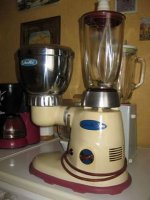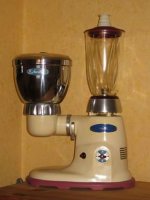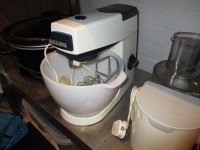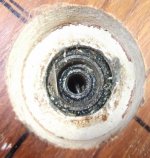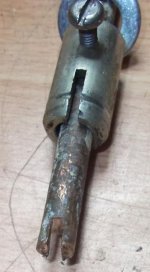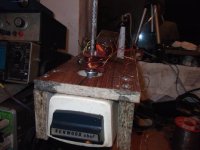Just like the Kitchen Aid's are here. If I hadn't dropped the old one, I'd still be using my Mom's century old one. I am still getting used to the lift bowl vs. the tilt head but that will come quickly.Kenwood chef A701 from the 1970s. They are still considered the work horse of an English kitchen even to the present day.
Thanks. I have used the old Czech made Porkert8 manual unit for decades. The KitchenAid unit is far nicer and easier to clean properly. It comes with its own radial 'bottle' brush. Part of the problem with the Porkert was the amount of time to clean and then oil before storing. Not to mention having one arm larger than the other. After a day of grinding, I looked like a tennis player.KitchenAid meat grinder attachment has a dozen clever hiding places
Can't imagine not taking it apart.Take it ALL THE WAY apart and scrub like the dickens.
The internet is flooded with good recipes. If you've not done it, take it slow. Start with a low to medium amount of seasonings. You can learn a lot from your first batch and then make your 2nd, 3rd... tailored to your tastes. Don't be afraid to try something a little different, just go easy at first. For example, if you like spicy, just put in a small amount of chili, you can always add later, but you can't take away. Same with garlic, dill, cloves or anything. It sits there for days at room temperature, so seasoning goes a long way.Got a tasty recipe for Sauerkraut or even better: the red cabbage equivalent?
Remember, never use table salt. The iodine slows and even kills the bacteria. OTOH it can be used at the end of fermentation to help stop it, if you don't want it to sour much further.
We have got a Kenwood chef A701 from the 1970s. They are still considered the work horse of an English kitchen even to the present day.
I have my mothers A701. My son is helping make cakes using it the same way I did. Gearbox sounds like it's on its way out, but still does the job.
I go back to day 1, with a Starmix from Germany the meat grinding attachment was all heavy castings and machined steel blades. When I got married we noticed that the motor unit had become a cockroach habitat and out it went. Clever Germans they were way ahead of Dyson.
One of the first electric food processors was the Starmix, introduced by German company Electrostar in 1946.[1][2] Although the basic unit resembled a simple blender, numerous accessories were available, including attachments for slicing bread, milk centrifuges and ice cream bowls.[3][4][5] In a time when electric motors were expensive, they also developed the piccolo, where the food processor's base unit could drive a vacuum cleaner.
No1 Electrostar Starmix collector's item.
Both cheaper and superior in every way to the equivalent Hobart Kitchenaid and Cuisineart models
Both cheaper and superior in every way to the equivalent Hobart Kitchenaid and Cuisineart models
Attachments
Last edited:
I have my mothers A701. My son is helping make cakes using it the same way I did. Gearbox sounds like it's on its way out, but still does the job.
The gearboxes always whine on the A701. The main servicing item is the minimum speed set by two screws accessed through the slots under the motor when the head is raised. My other half managed to jam the meat mincer/grinder and cracked the end of the gear box. It still runs and the ice cream maker drive is now being used for coil winding experiments. I got a call for a new one and had a look on Ebay and found one in mint condition and only 4 miles from home. It really had hardly been used so I bought it even though the price was a little bit more but not much when you take postage into account. It even has the vinyl dust cover.
Attachments
Reminds me I need a new glass jug. It survived my childhood, but not my wife placing it in the washing up zone when I wasn't looking. Amazing what spares you can still get new.
Oh and for 40 odd years I thought the round cover was a grease point, not a PTO!
Oh and for 40 odd years I thought the round cover was a grease point, not a PTO!
Channeling John Henry, give me a balloon whisk and a copper bowl and I will put any of these devices down re: egg whites.
I'm sure, but for those of us who only beat egg whites once a year the whisk does a good job.
(actually I think its been 6 years since the last attempt at meringues ended in disaster)
Using a chef as a winding attachment is brilliant tho! Next step is a lathe chuck for model making 😀
(actually I think its been 6 years since the last attempt at meringues ended in disaster)
Using a chef as a winding attachment is brilliant tho! Next step is a lathe chuck for model making 😀
I'm sure, but for those of us who only beat egg whites once a year the whisk does a good job.
I thought that was what I said.
I was going to say "Only once a year?" then I counted the months since I last meringued.
When my daughter was young we worked together to make meringue mushrooms. I must see if I can find pictures, they looked amazing (chocolate gills).
When my daughter was young we worked together to make meringue mushrooms. I must see if I can find pictures, they looked amazing (chocolate gills).
So here is a question for you pros: Tonight I decided to try a soup recipe which calls for clear chicken broth. Now I have been making chicken stock for years, but never bothered to clarify it. So this cookbook has a fairly simple recipe for chicken stock, then instructions to clarify it. I wish SY was here to answer my chemistry questions.
The instructions were to fully cool the stock, then in a food processor "liquidize" (why not liquify?) 3 egg whites and 200g of minced chicken meat, which I took to meand ground chicken. Not liking the idea of pink slime in prepackaged ground chicken I just diced a chicken breast (about 180g) and whizzed it with the egg whites, and a bit of the cold chicken stock. Then whisk that nasty mess into the 1.5 - 2.0 liters of chicken stock, bring to a boil until the foam makes a cake and slides up the pot, then off the heat and strain through cheese cloth.
Now, it worked really well, the cloudy stock came out sparkling! But does 3 egg whites seem like a lot? And what did the raw chicken meat bring to the party?
What is your preferred method, if any, for clarifying stock?
The instructions were to fully cool the stock, then in a food processor "liquidize" (why not liquify?) 3 egg whites and 200g of minced chicken meat, which I took to meand ground chicken. Not liking the idea of pink slime in prepackaged ground chicken I just diced a chicken breast (about 180g) and whizzed it with the egg whites, and a bit of the cold chicken stock. Then whisk that nasty mess into the 1.5 - 2.0 liters of chicken stock, bring to a boil until the foam makes a cake and slides up the pot, then off the heat and strain through cheese cloth.
Now, it worked really well, the cloudy stock came out sparkling! But does 3 egg whites seem like a lot? And what did the raw chicken meat bring to the party?
What is your preferred method, if any, for clarifying stock?
I thought that was what I said.
It probably was. It was very late and i'd had a few glasses of port!
I don't like meringue so I never make it but I have to beat eggwhites for the fresh cream gateaux I make for everybody's birthdays so about 4x a year.
I just use an electric handmixer for that. First time I made it I used a whisk and my arm nearly fell off. At least that is what it felt like...
I just use an electric handmixer for that. First time I made it I used a whisk and my arm nearly fell off. At least that is what it felt like...
Now, it worked really well, the cloudy stock came out sparkling! But does 3 egg whites seem like a lot? And what did the raw chicken meat bring to the party?
What is your preferred method, if any, for clarifying stock?
Egg fining is old school in wine making too. I think the collagen in meat is also similar to albumin, they trap the cloudy bits when the heat makes them solidify. IIRC Pho relies on the raw meat clarification alone. If you heat the juice lost by frozen chicken it forms the same white cloud as egg whites.
If you are serious it is the best way but I hate the waste. I have only done the egg whites, it is possible the ground meat also makes the result easier to filter (just guessing) the egg alone seems to clog up the works easily.
Last edited:
That makes sense, Scott, I hadn't thought about that white stuff that solidifies in pork and chicken juices.
The result was truly amazing, but a chicken breast and 3 egg whites is indeed wasteful. I feel like maybe just two egg whites and no meat would have got me 90% of the way there.
PS since I had 3 egg yolks left over I made spaghetti carbonara. Today I will finish the soup. The clarified stock was simmered with baked potato skins, and the potato will make gnocchi to add to the potato jacket broth.
The result was truly amazing, but a chicken breast and 3 egg whites is indeed wasteful. I feel like maybe just two egg whites and no meat would have got me 90% of the way there.
PS since I had 3 egg yolks left over I made spaghetti carbonara. Today I will finish the soup. The clarified stock was simmered with baked potato skins, and the potato will make gnocchi to add to the potato jacket broth.
... What about taking all the foam and bubbles away using patience and a spoon? Am I missing something?
Only did it once, about 13 years ago, but I had crystal clear stock. Took a long time but was the clearest stock ever. Time vested is not worth it though, tastes very slightly better cloudy.
So I just don't care anymore.
Only did it once, about 13 years ago, but I had crystal clear stock. Took a long time but was the clearest stock ever. Time vested is not worth it though, tastes very slightly better cloudy.
So I just don't care anymore.
Last edited:
- Home
- Member Areas
- The Lounge
- The food thread
